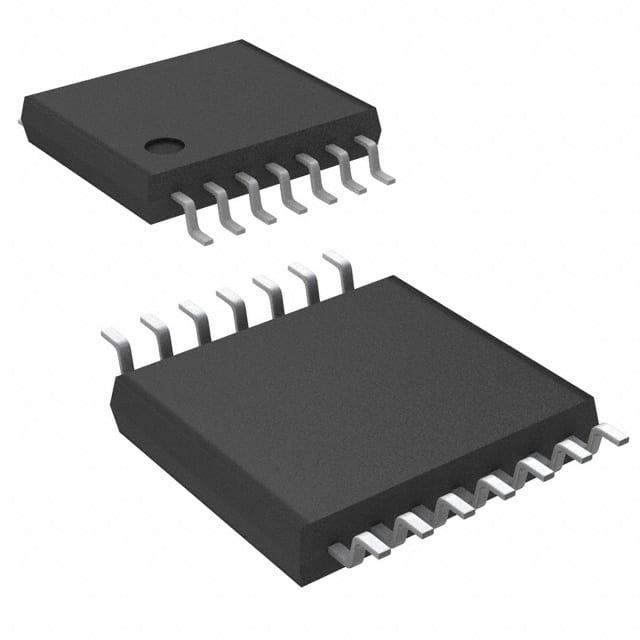74HC164T14-13
Product Overview
Category
The 74HC164T14-13 belongs to the category of integrated circuits (ICs).
Use
This IC is commonly used for serial-in, parallel-out shift register applications.
Characteristics
- Serial input and parallel output functionality
- High-speed operation
- Low power consumption
- Wide operating voltage range
- Compatibility with TTL levels
- Schmitt-trigger action on the input allows slow input transition and better noise immunity
Package
The 74HC164T14-13 is available in a TSSOP-14 package.
Essence
The essence of this product lies in its ability to convert serial data into parallel format, making it suitable for various digital applications.
Packaging/Quantity
The 74HC164T14-13 is typically packaged in reels or tubes, with a quantity of 2500 units per reel/tube.
Specifications
- Supply Voltage: 2V to 6V
- Input Voltage: -0.5V to VCC + 0.5V
- Output Voltage: -0.5V to VCC + 0.5V
- Operating Temperature Range: -40°C to +125°C
- Maximum Clock Frequency: 80 MHz
- Maximum Propagation Delay: 20 ns
Detailed Pin Configuration
The 74HC164T14-13 has a total of 14 pins, which are assigned specific functions as follows:
- GND: Ground
- SER: Serial Data Input
- QA: Parallel Output A
- QB: Parallel Output B
- QC: Parallel Output C
- QD: Parallel Output D
- QE: Parallel Output E
- QF: Parallel Output F
- QG: Parallel Output G
- QH: Parallel Output H
- MR: Master Reset Input
- CP: Clock Pulse Input
- VCC: Supply Voltage
- OE: Output Enable Input
Functional Features
The 74HC164T14-13 offers the following functional features:
- Serial data input is shifted into the shift register on each positive clock edge.
- The parallel outputs reflect the serial input after the specified number of clock cycles.
- The master reset input allows clearing the shift register to its initial state.
- The output enable input enables or disables the parallel outputs.
Advantages and Disadvantages
Advantages
- High-speed operation allows for efficient data processing.
- Low power consumption makes it suitable for battery-powered devices.
- Wide operating voltage range provides flexibility in various applications.
- Compatibility with TTL levels ensures easy integration with existing systems.
- Schmitt-trigger action on the input enhances noise immunity.
Disadvantages
- Limited number of parallel outputs (8 in this case) may restrict certain applications requiring more outputs.
- Lack of built-in error detection or correction mechanisms.
Working Principles
The 74HC164T14-13 operates based on the principle of shifting data from the serial input to the parallel outputs. On each rising edge of the clock pulse, the input data is shifted one bit to the right, while the previously shifted bits are stored in the parallel outputs. The master reset input can be used to clear the shift register, and the output enable input controls the activation of the parallel outputs.
Detailed Application Field Plans
The 74HC164T14-13 finds applications in various fields, including but not limited to:
- Digital communication systems
- Data storage devices
- Industrial automation
- Automotive electronics
- Consumer electronics
- Robotics
- Instrumentation and measurement equipment
Detailed and Complete Alternative Models
There are several alternative models available that offer similar functionality to the 74HC164T14-13. Some of these include:
- SN74HC164N
- CD74HC164E
- MC74HC164AN
- 74HCT164
These alternative models can be considered based on specific requirements, availability, and cost considerations.
In conclusion, the 74HC164T14-13 is a versatile integrated circuit used for serial-in, parallel-out shift register applications. Its high-speed operation, low power consumption, and compatibility with TTL levels make it suitable for various digital applications. However, its limited number of parallel outputs and lack of built-in error detection may pose limitations in certain scenarios. Nonetheless, this IC provides an efficient solution for converting serial data into parallel format, finding applications in diverse fields such as communication systems, data storage devices, and industrial automation.
10個與74HC164T14-13在技術方案中應用相關的常見問題與解答
Sure! Here are 10 common questions and answers related to the application of 74HC164T14-13 in technical solutions:
Q: What is the 74HC164T14-13? A: The 74HC164T14-13 is a 14-bit serial-in, parallel-out shift register IC (integrated circuit) commonly used in digital electronics.
Q: What is the purpose of a shift register? A: A shift register allows for the sequential shifting of data bits, either serially or in parallel, making it useful for tasks like data storage, data transfer, and control signal generation.
Q: How many bits can the 74HC164T14-13 handle? A: The 74HC164T14-13 can handle up to 14 bits of data.
Q: What is the maximum clock frequency supported by the 74HC164T14-13? A: The 74HC164T14-13 can support clock frequencies up to 100 MHz.
Q: Can the 74HC164T14-13 be cascaded to increase the number of bits? A: Yes, multiple 74HC164T14-13 ICs can be cascaded together to increase the number of bits that can be handled.
Q: What is the power supply voltage range for the 74HC164T14-13? A: The 74HC164T14-13 operates with a power supply voltage range of 2V to 6V.
Q: Does the 74HC164T14-13 have built-in output latches? A: No, the 74HC164T14-13 does not have built-in output latches. The outputs are directly driven by the input data.
Q: Can the 74HC164T14-13 be used for both serial and parallel data transfer? A: Yes, the 74HC164T14-13 can be used for both serial-in, parallel-out (SIPO) and parallel-in, serial-out (PISO) data transfer operations.
Q: What is the typical power consumption of the 74HC164T14-13? A: The typical power consumption of the 74HC164T14-13 is around 10mW.
Q: What are some common applications of the 74HC164T14-13? A: The 74HC164T14-13 is commonly used in applications such as LED matrix displays, shift register-based counters, serial-to-parallel converters, and control signal generation in digital systems.
Please note that the answers provided here are general and may vary depending on specific datasheet specifications and application requirements.


